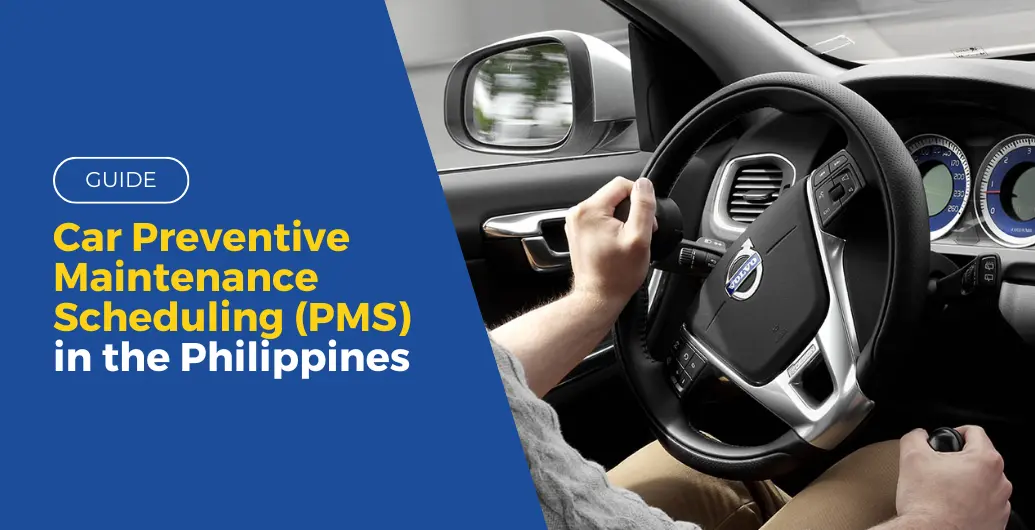Estimated reading time: 5 minutes
The Philippines is prone to many typhoons that bring torrential rains, which can last for days, affecting lives and properties. Among these properties are land vehicles that are susceptible to water damage. Car manufacturers recommend PMS to reduce the damage done to their vehicles. But, what is PMS? Here is a brief guide on when to do Preventive Maintenance Scheduling (PMS) on your car.
Table of contents
What Does PMS Mean In Cars?
Preventive Maintenance Scheduling (or Periodic Maintenance Service) is a manual given to new car owners. It helps the owners when to check for possible damages on their vehicles. Thanks to the advancements in Mechanical Engineering and Material Science, car companies can predict when a part will start to break down.
They calculate the material’s fatigue stress and the total amount of revolutions a gear undergoes per distance traveled. In PMS manuals, you are reminded that you should have your vehicle checked up by professionals once you achieve a fixed travel distance.
What Is Preventive Maintenance For Cars?
Preventive maintenance is servicing done on cars to stop further damage at the first sign of wear and tear. If a component breaks down during operation, it becomes a hazard to owners and the people near the machine.
Also Read: GUIDE: LTO Car Registration Renewal
Where Do I Avail PMS For My Car?
PMS is strongly advised to be done at a repair shop authorized by your car’s manufacturer. Though it might cost you some money, nobody knows your vehicle better than the manufacturer. Moreover, any adjustments a third-party repair shop makes will void your car’s warranty.
Not doing preventive maintenance will not only damage your car but will also shorten its effective lifespan. In addition, not sticking to the scheduled maintenance will also void your warranty, even if it’s only a day after. So make sure you read your car manual and warranty to avoid hiccups.
What Are Included In The Preventive Maintenance Schedule?
PMS mainly checks on the most commonly damaged components first. These components are Oil Filters, Belts, and Transmission. These are the first ones to break down due to the constant heat and friction these parts undergo.
Oil Change and Oil Filter
The primary function of oil in your car is to lubricate its parts since tight tolerances are observed for such machines to perform efficiently. Therefore, any loss of efficiency will result in greater fuel consumption and a reduction in vehicle performance.
An Oil Change is done since impurities enter the system and get mixed with the oil, which changes the oil’s properties. These impurities include dust, smoke, rust, and metal particles that can damage your car if not removed.
The Oil Filter is responsible for preventing these impurities from entering the system in the first place, though some finer particles get mixed and enter the system. A high-quality Oil Filter keeps the oil clean for a long time and might also allow for reusability.
Belts
Belts are constantly under tension to facilitate an efficient energy transfer from one point to another. In addition, they are cheap, light, and easy to replace compared to complex gearboxes. However, these components wear down quickly since they are made of rubber, and these rubbers are constantly under heat and stress during operation.
Any visible tear in the belt makes it subject to change since it reduces the stress the belt can endure and might break while on the road. Elongation is also a change factor, even if no tear is visible.
Transmission
The car transmission is responsible for changing the vehicle’s torque and speed. It is made up of a gearbox where gears are used as a means of energy transfer. Unfortunately, since these gears operate under very tight tolerances, they are often damaged by friction, even in the presence of high-quality lubricants.
If your gear stick feels weird when operated or sounds not heard before are generated, it’s a significant indication that your transmission is damaged beyond repair and needs a replacement. Preventive maintenance will prevent things like this from happening and reduce the damage done to your vehicle!
Also Read: LIST: Electric Mini Cars in the Philippines (with prices!)
When To Bring Your Car For PMS
PMS varies from each car and manufacturer. Some manufacturers recommend a timely approach, while others are based on distance traveled. Always check your vehicle’s manual to know your schedule.
Typical PMS schedules for brand-new cars are when it has traveled 1000 km. Car manufacturers will renew your PMS schedule and check your:
> Tires
> Brakes
> Transmission
> Coolant and Radiator
> Engine Oil and Oil Filter
They will also check for leaks and fix any errors, such as loosened bolts and belts.
Final Thoughts
In the past, owning a vehicle was considered a luxury in the Philippines. Today, it is regarded as an investment in our constantly improving economy. Public transport has improved a lot since then, but it’s still unable to meet the need for a cheap and comfortable way to travel.
Periodic Maintenance Service (PMS) is the best way to keep your car efficient and increase its lifespan. Not only will you reduce your overall spending, but you will also get the most out of your beloved car. – WhatALife!
Also read: LGU Salary Grade in the Philippines for the Year 2022

Leave a Reply